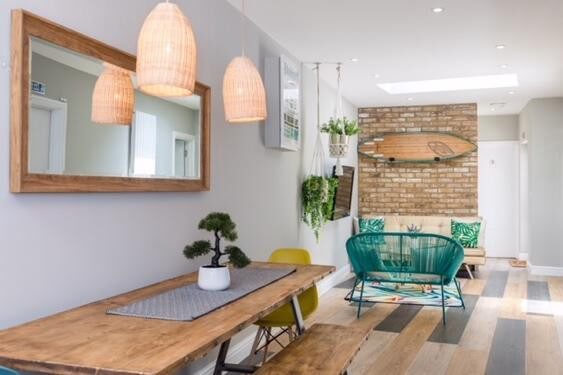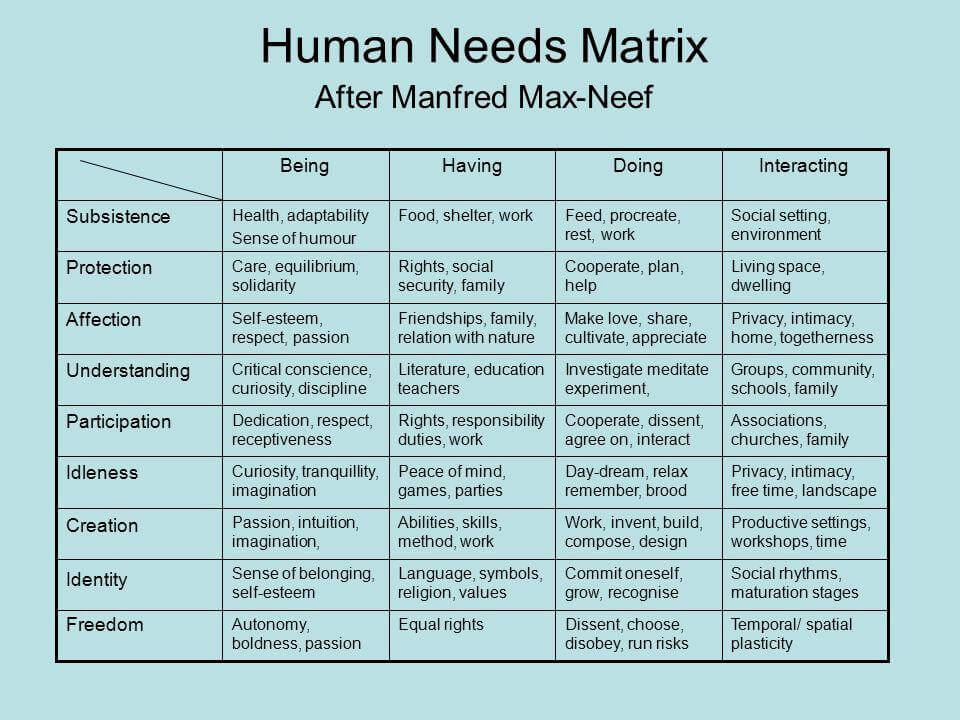How can shared living support people, cities and the world to meet Max-Neef’s Fundamental Human Needs? In this article, Impact Consultant Gabriel Voto explores this topic at large.
Also, tune in to Coliving Conversations (Season 1) 🎙️ 🏠 💚 to explore ways shared living can tackle loneliness and other needs.
Ready? Let’s explore.
Who is Max-Neef?
A deep bow towards you, Artur Max-Neef.
From the height of his 86 years of an amazingly fruitful existence, Artur Manfred Max-Neef made his transition from our world last month, on the 8th of August of 2019. This is a piece I’ve been working on for some time and now seemed to be the perfect time to share it.
Born in Valparaiso, Chile, on the 26th of October of 1932, Max-Neef grew to be one of the most influential minds of our century. Having studied and taught economics at the University of California, he was able to deeply study and analyse, whilst also understanding the management needed for our ‘eco’ or ‘oikos’ . His successful academic career started in the early 60s, in which he was awarded Soka’s University Highest Honour and a Doctor Honoris Causa at Jordan University. Max was a skilled politician, having finished in 4th on the Chilean presidential elections in 1993.
He worked predominantly in very deprived places, from India to Chile. And I personally enjoy the description of one of his most powerful experiences in one of the ‘pueblos’. Whilst barefoot in the mud, he realized that his formal career as a successful economist in University of California didn’t provide him with the structure to understand that reality he was facing, nor to reflect on that reality and propose useful interventions. He needed to completely let go of all his past learnings to enter a new space of deep emergence and complexity. That’s when he coined the term “barefoot economics”, and from that moment on he started having a much broader perspective on our collective ‘oikos’.
Max-Neef's Vision
In 1981, Max-Neef wrote one of his main works, called “From the Outside Looking In: Experiences in Barefoot Economics”. It discusses an economic approach that encapsulates and prioritizes people’s needs in places suffering from extreme poverty. His work revitalizing small and medium-sized communities through ‘Barefoot Economics’ in deprived areas led to the Right Livelihood Award (aka “Alternative Nobel Prize”) in 1983. He also was awarded the National Prize for the Promotion and Defense of Human Rights in Chile funded the national research center for sustainable urban development CEPAUR (Centro de Estudio e Promoción de Asuntos Urbanos).
What mostly resonates with me is Max’s outstanding systemic understanding of our most basic human needs, and the realization that they need to be met simultaneously. I’ve always had a problem with Abraham Maslow’s pyramid of needs, and the hierarchical view that it implies regarding who is “rich” and who is “poor”. Having also worked in very deprived area in the favelas of Brazil, I think that people living in poverty should also have the ability to fulfill their needs of love, belonging, esteem and self-actualization, regardless being exposed to systemic structures undermining their safety and subsistence.
In fact, I would advocate that aspects of the health of the social fabric in favela neighborhoods are higher and healthier than in some communities I’ve worked with/lived in much richer countries in the Americas and Europe. The people of the favelas are amazingly resourceful and creative, their relationships are warm and meaningful. They are engaged and courageous, exercising their rights even when it means facing violent responses from the estate. All this even in the face of the highest levels of deprivation on basic sanitation and financial access.
Max-Neef and his definition of the Fundamental Human Needs showed that no one should be considered too poor to seek fulfillment of all their fundamental needs. He developed a taxonomy of the fundamental human needs and human scale development. Like myself, Max was also very interested in understanding the economy in more financially deprived countries, where people live on the level 1, where also the inappropriateness of the most traditional economic models has led to chronic issues of economic poverty, international debt and depletion of natural resources.
Neef’s main contribution to the understanding of human needs for me is the distinction he made between needs and satisfiers. Human needs are seen as finite and classifiable, they are also constant through all human cultures since prehistoric times. The only thing changing over time is the way we satisfy those needs, or the satisfiers. I will explain more about each human need and the different types of satisfiers later on.
What is Coliving?
Coliving communities have been popping up all over the world. Some of the words assiciated with coliving are: Belonging. Convenience. Connection. Community. If you are not fully familiar with what coliving homes are, you can find more information about this growing trend here:
- What is coliving? What are its benefits for neighborhood, cities & the world?
- Embedding, Measuring & Optimising ESG in coliving
- Coliving business models & typologies
Ok, back to Max’s fundamental human needs:
Light touch on the Fundamental Human Needs
Different from the common notion postulated by Western psychologist Abraham Maslow, Neef advocated that there should be no hierarchy of needs apart from the basic need for subsistence or survival. Instead they should be met simultaneously. The human needs are also complex, connected and interactive, hence needing a systemic approach. According to his approach, there should always be awareness of the complementarity and trade-offs that are present on the process of satisfying each of the needs.
Max-Neef classifies the fundamental human needs as: subsistence, protection, affection, understanding, participation, recreation, creation, identity and freedom. Needs are also defined according to the existential categories of being, having, doing and interacting. Below a matrix to clarify the concept.
Every human need can be ‘satisfied’ in different ways, either being, doing, having or interacting, and this is where it gets very interesting! Satisfiers also have different characteristics: they can be destroyers or violators, pseudo satisfiers, inhibiting satisfiers, singular satisfiers, or synergic satisfiers. We should be aiming for those last two, and especially for the latter.
This means that the ways we satisfy our needs are not necessarily’sustainable’ on the medium to long term, by meeting one need incautiously, we could be hindering or jeopardizing our ability to meet the other need(s).
Let’s use the example of a dictatorship, such as my country Brazil was submitted to for 20 years. While ostensibly satisfying the need for protection, in fact it ends up destroying subsistence, participation, affection and freedom. Or at a family level we could think about overprotective parents, where satisfying the need for protection it can also affect affection and freedom. Commercial television and media are also a good example, while used to satisfy the need for recreation, ends up many times interfering negatively with understanding, creativity and identity needs.
Synergic satisfiers, on the other hand, not only satisfy one particular need, but also lead to satisfaction in other areas: some examples are breast-feeding which satisfies simultaneously the need for subsistence and affection; but one can see examples everywhere such as meditation on satisfying freedom, creation and identity, or educational games satisfying the needs for understanding, affection, creation, etc. One of the potentially best synergistic satisfiers in my opinion are democratic community and organizations. Through the existence of such social spaces, many needs can be met simultaneously.
"Conscious" coliving as the ultimate synergetic satisfier for the Fundamental Human needs
In this series of articles, I will discuss why I believe each and every single fundamental human needs has the potential to be satisfied in a synergetic way with a purposeful and coliving offer. I will offer some suggestions and advice for coliving developers and operators on how to design from customer experiences to communal areas and events, all this in order to maximize the potential for meeting simultaneously all the human needs. This will hopefully create long term customer loyalty and will boost the attractiveness of your coliving space over other competitors.
I deeply believe that more than just the subsistence factor of having a roof above our heads, coliving could provide the opportunity for us as humans to flourish with our full potential. It could spark the creation of more diverse, engaged, purposeful and informed communities, harnessing the collective will and power for a better planet, one (conscious) coliving space at a time.
Stay tuned over the upcoming months as I will share some examples on how I believe a sustainable and conscious coliving offer could potentially support our society to meet all our fundamental human needs simultaneously.
In this first piece I will explore how coliving meets the subsistence need in a systemic way.
Subsistence & Coliving
Subsistence is connected partly to the more primal needs we have as a species.
The need to eat, to rest, to procreate, as well as a shelter to protect us from the weathering. Without this need met we cannot even survive.
Additionally, to those more emergent needs, subsistence is also connected to more subjective self-expression aspects, such as developing sense of humour, and broader interactions on social settings. Coliving could help to fulfill this need by providing more than just a shelter.

How? By designing a living environment where aspects of health and wellbeing are carefully analyzed from the design phase, all the way through construction and operationalization.
Being
I saw first-hand that coliving has a huge potential to provide a place where the residents and members of the extended local community have the opportunity to take care of their physical and mental health. Last year I was working as the Impact Manager with The Collective, a global coliving developer and operator. My remit was to oversee, guide and ensure accountability with all environmental, social and governance strategy.
I co-developed the business strategy regarding our impact and also implemented projects on the ground. I was lucky enough to be working on the world’s largest coliving development in operation in 2018, The Collective Old Oak, located in northwest London. A big part of my time was dedicated to develop direct contact with the members, and I was able to perceive the change in their habits on a daily basis, what kind of messages they would be more prone to accept, which ones they would be more resistant to. It was a kind of a big anthropological experiment for me.
At Old Oak, the community was amazingly diverse, representing a microcosmos of London itself. I have witnessed how the diversity of our coliving community challenged people’s social perspective, beliefs and assumptions. By curating safe spaces for collective discussion and reflection, suddenly people start seeing diversity as an asset rather than something to be afraid of. And in that process, open up to be more flexible and adaptable towards different cultures and ways of being.
Regarding the design of the premises, it’s always important to develop integrated spaces where the residents are able to take care of their physical and mental health.
In many coliving spaces there’s a fully functional gym within the premises of the building. In Old Oak the gym membership is attached to the resident’s contracts and there’s also a discount at the local plastic-free café which specializes in natural and slow food. There is also the support of an in-house personal trainer who lives at the building, who runs inclusive weekly bootcamps.
This type of support by nudging healthy habits, by making it easier for the residents to make better choices regarding their health and wellbeing is really important. This way the residents will be able to create long term healthy habits for themselves, and will also influence other members of the community. I’ve seen some fantastic stories about residents really starting to take better care of their physical and mental health after moving to Old Oak.
Other important suggestion is to include spaces and events where the residents have the opportunity to engage in other punctual activities focused on health and wellbeing such as urban gardening or having time socializing over meaningful activities such as local clean up actions. Lighter and fun activities are also highly recommended such as community quizzes, live music and stand-up comedy nights, as they develop the collective sense of humor as well.
Having
Coliving developments shouldn’t be seen or developed as normal buildings, as a simple collective shelter, as it has the potential to give much more. The common areas and events could and should always be designed with the health and wellbeing of the users at the center.
WELL certification is currently a very powerful and important tool to facilitate the implementation of this type of design and support inclusive and scientifically based discussions on how our buildings can provide the highest degree of support on meeting our needs connected to health and wellbeing. They go further and advocate that buildings should take care of us in a systemic way, as nature has always been doing.
Nature has long been our caretaker.
With intentional design, our buildings can be too.WELL Building Standard
Finally, there’s even the potential to offer work for members of the coliving communities. The Collective developed the Ambassadors Programme, in which residents are invited to step up to a leadership position, representing the wider community within the management and design of the coliving offer.
Doing
Technology has a big role to play by enabling and facilitating the spread of wellbeing focused design, enabling better spaces where we can fulfill our need to feed, work, rest and so forth.
Biophilic design is a concept that advocates that the built environment should mimic nature in order to support the occupant’s wellbeing.
To illustrate this on a practical level I bring the example of B-Hive living.

B-Hive incorporates biophilic design in the spaces and use it in the business theory of change. Williams Motta, CEO of B-Hive expands on the topic:
Nature is our guideline, we mix natural and reclaimed materials with artefacts of modern life in bold ways to invoke a sense of well-being and wonder.
Williams Motta, CEO of B-Hive Coliving
Another concrete and very impressive example of this concept is the development of circadian light systems. It’s a system connected to the world’s clock through the internet of things, and provides natural light intensity accordingly to the external environment throughout the day. Other examples of biophilic design are the use of natural materials, with nature-based textures and colors and the simple use of indoor plants.
In regards to having the potential to provide or influence on food and beverage offers, coliving operators should be aware of the potential again to support and nudge healthy habits to the residents. The procurement policies should always have the scope to prioritize organic and ethically sourced products. And if there’s any external space there’s also the potential to create a public allotment around the development as public realm, or a rooftop garden.
Interacting
We’ve explored a bit regarding space design and curation already. Another very important aspect to be able to unleash the potential for social settings is the team and community composition. It’s all about people at the end of the day when you are offering people homes. There’s always the need to create social settings that are as diverse and inclusive as possible, hence there’s the need to select the staff (and members of the community) that will deeply care for the internal and external community on a daily basis.
A suggestion is to use the soft-landing approach on the onboarding process. This means that both the potential members and potential staff get to spend real time with the real community. The right candidates could be then selected by being observed on more subjective aspects, such as personality traits and soft skills. It’s essential the new members of the community are able to design and implement adaptive and resilient social settings.
Finally, coliving doesn’t only have the potential to influence in human subsistence, but also on the subsistence of our planet. By verticalizing housing and increasing occupation density it means that all the inputs and outputs of the coliving schemes can be designed for minimizing and even zeroing the environmental impact on some aspects. From waste management, to energy and water consumption, the potential is immense.
Well, that’s it for this first article on coliving as a tool to meet the fundamental human needs. Thanks for reading it, hope you enjoyed it and if you did, stay tuned for the next articles of this series. Our next one will be about the Protection and Affection needs and I’m planning to share it in November.
About Me & Conscious Coliving
Hi! My name is Gabriel Neira Voto, I’m a tropical blooded human from Rio de Janeiro living in the old continent. I’m passionate about supporting the creation and operationalization of sustainable communities and endeavors. I’ve worked on both extremes of the social spectrum. From grassroots projects in the biggest slum of latin America, where I co founded an award-winning NGO, all the way to being a sustainability manager at the corporate real estate sector in London.
Through my experience people often called me an optimist, always keen to work with highly complex social systems. I consider myself a ‘possibilist’ though, one that is really excited about the potential coliving has to shape our society in a positive way. Hans Rosling once said,
“As a possibilist, I see all this progress, and it fills me with conviction and hope that further progress is possible. This is not optimistic. It is having a clear and reasonable idea about how things are. It is having a worldview that is constructive and useful.”
I am also a sustainability professional with 9 years of related work experience in social and environmental impact. I accumulated a strong track record in creating effective and innovative solutions, notably in the corporate and charity sectors.
More recently I’ve worked in the shared living sector as the Impact Manager for The Collective (Living) LLP, co-leading on both impact strategy development and operational projects. With a focus on sustainable urban development and community facilitation, I specialized on topics such as social value, social return on investment, innovative public engagement and biodiversity net gain. More recently I have collaborated with B-Hive living as a social impact advisor. I also work as a senior coliving consultant at Conscious Coliving.
Are you a coliving or hospitality developer/operator willing to create the ultimate customer experience & long term loyalty, guaranteeing that:
- your occupancy rates are up the roof, constantly;
- your void period is as brief as possible;
- your retention rates are outstanding;
- you create huge custome apetite with your offer, securing a never-ending waiting list to join your space(s)?
Then we would love to hear from you.
This article has been authored for you by:
Gabriel is a sustainability professional with 9 years of experience in social and enviromental impact, notably in the corporate and charity sectors. Gabriel supported The Collective as Impact Manager, co-leading on their impact strategy.

